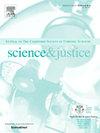Age characterization of donor based on fatty acid substances analysis in fingermarks
IF 1.9
4区 医学
Q2 MEDICINE, LEGAL
引用次数: 0
Abstract
As a critical frontier in forensic science, the profiling of physical evidence characteristics has garnered substantial attention. This study employed gas chromatography-mass spectrometry (GC–MS) to investigate age-related differences in sebaceous fingermark fatty acid compositions. Fingermark samples from 80 volunteers were analyzed to characterize fatty acid profiles across different age groups. Non-parametric tests were used to identify target fatty acids with significant age-dependent variations, followed by comparative evaluation of unsupervised (PCA) and supervised (RBF, MLP) classification models to develop a high-accuracy age prediction framework. Results revealed distinct fatty acid trends with age: younger donors predominantly exhibited saturated fatty acids with carbon numbers ≤ 10; mid-chain saturated fatty acids (C10–C20) showed minimal age-related variation; and long-chain fatty acids (C ≥ 20) were more abundant in older donors. Significant age-group differences were identified for octanoic acid, decanoic acid, palmitoleic acid, palmitic acid, oleic acid, stearic acid, behenic acid, and tetracosanoic acid. The multi-layer perceptron (MLP) model achieved an overall accuracy of 84.6 %, outperforming other algorithms in age classification. This study enhances the understanding of age-related lipid dynamics in sebaceous fingermarks and establishes a robust analytical pipeline for forensic age profiling, offering practical implications for criminal investigation and biometric identification.
基于手印中脂肪酸物质分析的供体年龄鉴定
物证特征侧写作为法医学的一个重要前沿领域,受到了广泛的关注。本研究采用气相色谱-质谱联用技术(GC-MS)研究皮脂腺指印脂肪酸组成的年龄相关性差异。研究人员分析了来自80名志愿者的指纹样本,以确定不同年龄段的脂肪酸特征。使用非参数检验来识别具有显著年龄依赖性变化的目标脂肪酸,然后对无监督(PCA)和监督(RBF, MLP)分类模型进行比较评估,以建立高精度的年龄预测框架。结果显示出不同年龄的脂肪酸变化趋势:年轻供体主要表现出碳数≤10的饱和脂肪酸;中链饱和脂肪酸(C10-C20)表现出最小的年龄相关变化;长链脂肪酸(C≥20)在老年供体中含量更高。辛酸、癸酸、棕榈油酸、棕榈酸、油酸、硬脂酸、脱黑酸和四烷酸的含量在年龄组中存在显著差异。多层感知器(MLP)模型的总体准确率为84.6%,在年龄分类方面优于其他算法。本研究增强了对皮脂腺手印中与年龄相关的脂质动力学的理解,并为法医年龄分析建立了一个强大的分析管道,为刑事调查和生物识别提供了实际意义。
本文章由计算机程序翻译,如有差异,请以英文原文为准。
求助全文
约1分钟内获得全文
求助全文
来源期刊

Science & Justice
医学-病理学
CiteScore
4.20
自引率
15.80%
发文量
98
审稿时长
81 days
期刊介绍:
Science & Justice provides a forum to promote communication and publication of original articles, reviews and correspondence on subjects that spark debates within the Forensic Science Community and the criminal justice sector. The journal provides a medium whereby all aspects of applying science to legal proceedings can be debated and progressed. Science & Justice is published six times a year, and will be of interest primarily to practising forensic scientists and their colleagues in related fields. It is chiefly concerned with the publication of formal scientific papers, in keeping with its international learned status, but will not accept any article describing experimentation on animals which does not meet strict ethical standards.
Promote communication and informed debate within the Forensic Science Community and the criminal justice sector.
To promote the publication of learned and original research findings from all areas of the forensic sciences and by so doing to advance the profession.
To promote the publication of case based material by way of case reviews.
To promote the publication of conference proceedings which are of interest to the forensic science community.
To provide a medium whereby all aspects of applying science to legal proceedings can be debated and progressed.
To appeal to all those with an interest in the forensic sciences.
 求助内容:
求助内容: 应助结果提醒方式:
应助结果提醒方式:


